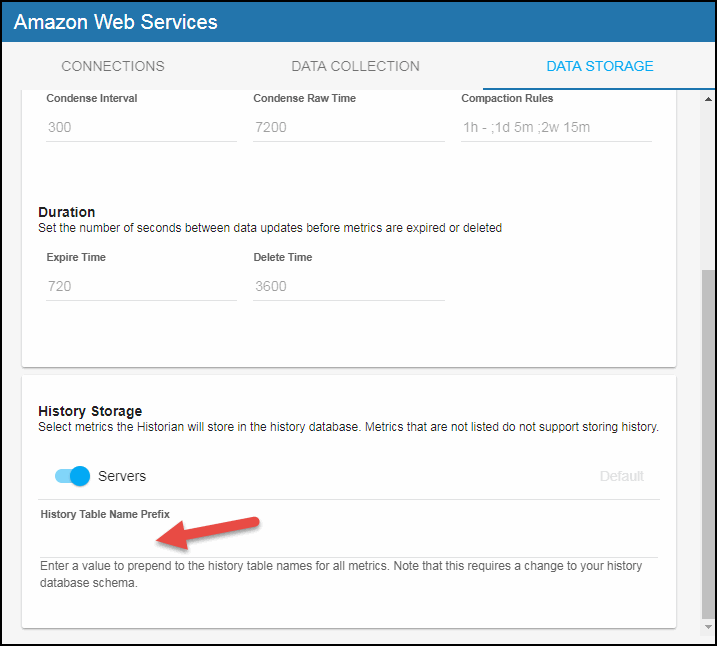Configuring Amazon Web Services, Version 5.1.1
This section describes the configuration steps (required and optional) needed to set up the Amazon Web Services solution package.
Configuring Data Connections
To configure data connections for the Solution Package for Amazon Web Services:
- Copy the following jars from your AWS SDK to a single directory. The jars are:
aws-java-sdk-*.jar
commons-codec-*.jar
httpclient-*.jar
httpcore-*.jar
commons-logging-*.jar
jackson-annotations-*.jar
jackson-core-*.jar
jackson-databind-*.jar
joda-time-*.jar
- Navigate to Solution Package Configuration > Amazon Web Services > CONNECTIONS tab.
- On the CONNECTIONS tab, provide the correct full path to the directory containing the Amazon Web Services SDK jar files in the Classpath field. Use forward slashes in path name. For env vars, always use %% (including on UNIX).
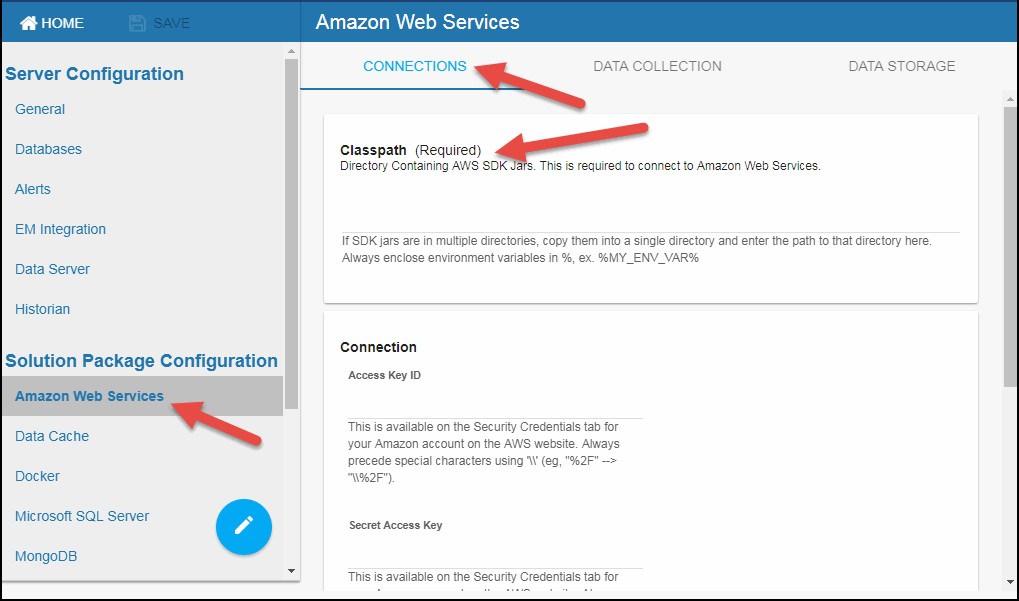
- In the Connection region, specify the following:
Access Key ID- Obtain this value by browsing to your Amazon account on the Amazon Web Services website > Security Credentials tab.
Secret Access Key- Obtain this value by browsing to your Amazon account on the Amazon Web Services website > Security Credentials tab. “Quote” special characters using \\ (eg, %2F --> \\%2F).
Endpoint - The fully-qualified DNS name for an Amazon service (CloudWatch) that provides monitoring data. For a list of endpoints for Amazon CloudWatch refer to https://docs.aws.amazon.com/general/latest/gr/rande.html.
Initial History- The number of hours of past history to retrieve for first query to ACW. The default is 2 hours. Subsequent queries use a time window of 1 minute.
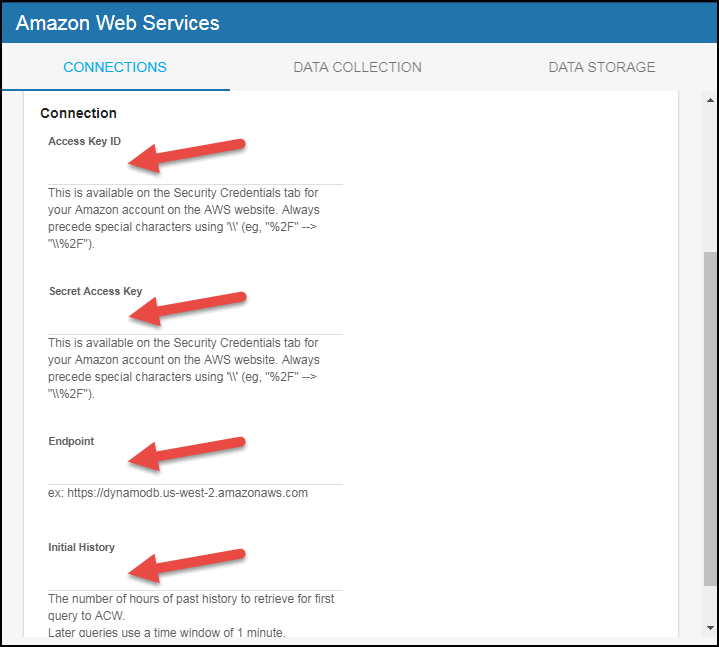
Configuring Data Collection (Optional)
If you want to modify the default values for the update rates for the TIBCO ActiveMatrix caches, you can update the default polling rates (query interval, in seconds) used to collect the metric data in the Poll Rates field.
To update the polling rates for the Solution Package for Amazon Web Services:
- Navigate to Solution Package Configuration > Amazon Web Services > DATA COLLECTION tab.
- In the Poll Rate field, enter the time interval, in seconds, to check for data updates. The default is 30 seconds. The AwsEc2InstanceStats andAwsEc2Instances caches are impacted by this field.
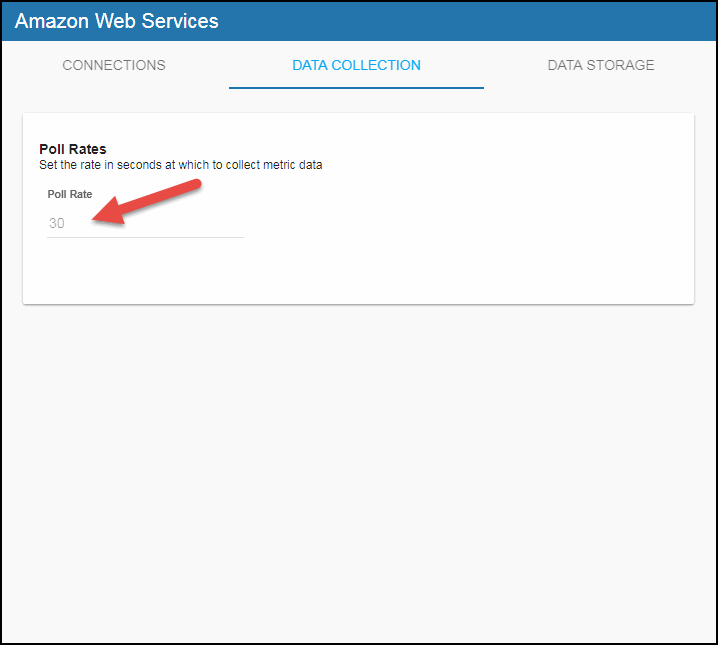
Configuring Historical Data Collection (Optional)
You can specify the number of history rows to store in memory, the compaction rules, the duration before metrics are expired and deleted, and the different types of metrics that you want the Historian to store in the DATA STORAGE tab in the RTView Configuration Application. These configurations already contain default values and modifications to these configurations are optional..
Defining the Storage of In Memory History
You can modify the maximum number of history rows to store in memory in the DATA STORAGE tab. The History Rows property defines the maximum number of rows to store for the AwsEc2InstanceStats cache. To update the default settings:
- Navigate to the Solution Package Configuration > Amazon Web Services > DATA STORAGE tab.
- In the Size region, click the History Rows field and specify the desired number of rows.
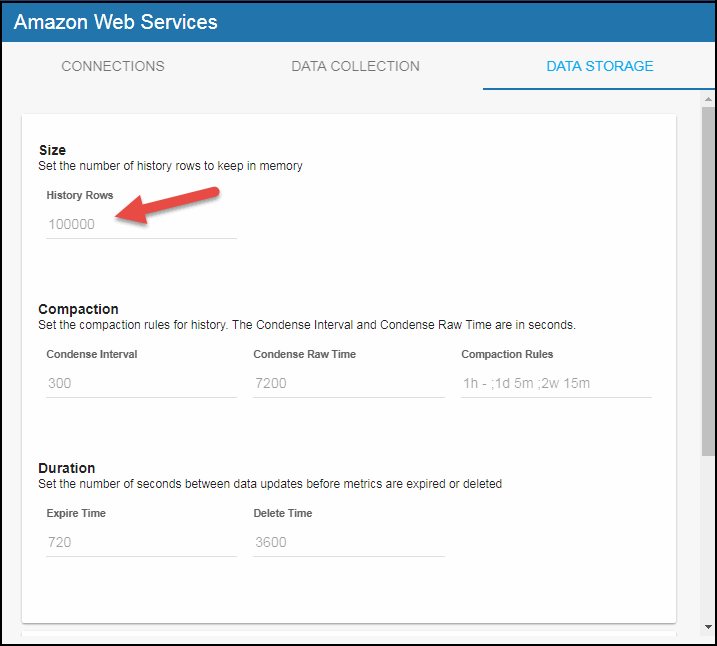
Defining Compaction Rules
Data compaction, essentially, is taking large quantities of data and condensing it using a defined rule so that you store a reasonably sized sample of data instead of all of your data, thus preventing you from potentially overloading your database. The available fields are:
Condense Interval -- The time interval at which the cache history is condensed. The default is 300 seconds. The following cache is impacted by this setting: AwsEc2InstanceStats.
Condense Raw Time -- The time span of raw data kept in the cache history table. The default is 7200 seconds. The following cache is impacted by this setting: AwsEc2InstanceStats.
Compaction Rules -- This field defines the rules used to condense your historical data in the database. By default, the columns kept in history will be aggregated by averaging rows with the following rule 1h -;1d 5m;2w 15m, which means the data from 1 hour will not be aggregated (1h - rule), the data over a period of 1 day will be aggregated every 5 minutes (1d 5m rule), and the data over a period of 2 weeks old will be aggregated every 15 minutes (2w 15m rule). The following cache is impacted by this setting: AwsEc2InstanceStats.
- Navigate to the Solution Package Configuration > Amazon Web Services > DATA STORAGE tab.
- In the Compaction region, click the Condense Interval, Condense Raw Time, and Compaction Rules fields and specify the desired settings.
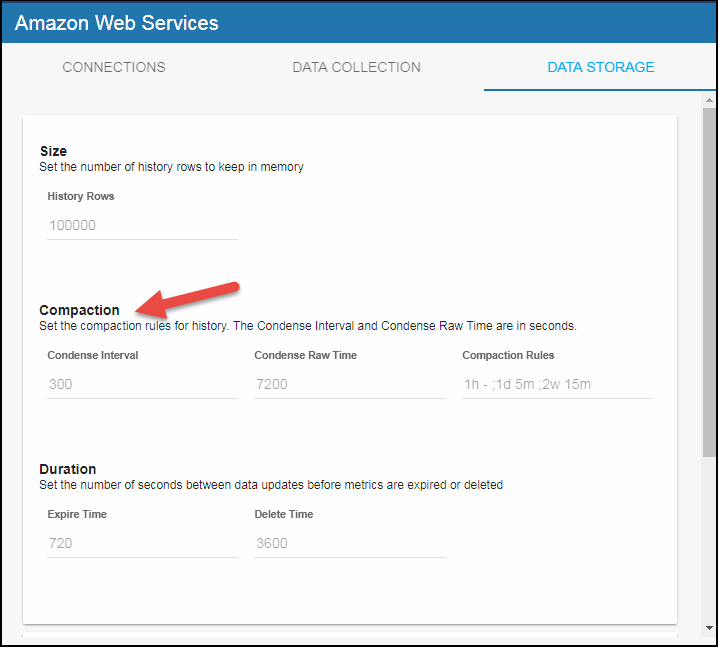
Defining Expiration and Deletion Duration for AWS Metrics
The data for each metric is stored in a specific cache and, when the data is not updated in a certain period of time, that data will either be marked as expired or, if it has been an extended period of time, it will be deleted from the cache altogether. The Expire Timefield, which sets the expire time for the AwsEc2InstanceStats and AwsEc2Instances caches, defaults to 720 seconds. The Delete Time field, which sets the delete time for the AwsEc2InstanceStats and AwsEc2Instancess caches, defaults to 3600 seconds. To modify these defaults:
- Navigate to the Solution Package Configuration > Amazon Web Services > DATA STORAGE tab.
- In the Duration region, click the Expire Time and Delete Time fields and specify the desired settings.
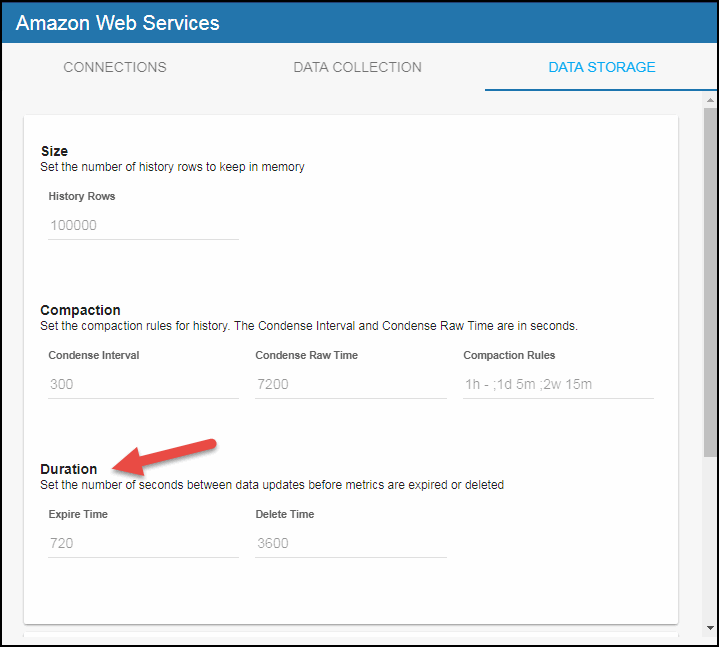
Enabling/Disabling Storage of Historical Data
The History Storage region allows you to select which metrics you want the Historian to store in the history database. By default, the Servers historical data is saved to the database. To enable/disable the collection of historical data, perform the following steps:
- Navigate to the Solution Package Configuration > Amazon Web Services > DATA STORAGE tab.
- In the History Storage region, select the toggle for the Servers metric to enable/disable collection of the metric. Blue is enabled, gray is disabled.
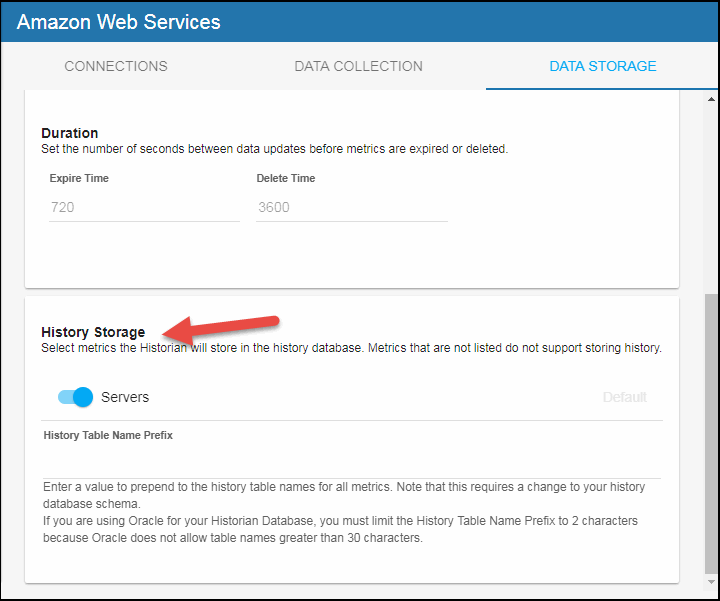
Defining a Prefix for All History Table Names for AWS Metrics
The History Table Name Prefix field allows you to define a prefix that will be added to the database table names so that the Monitor can differentiate history data between data servers when you have multiple data servers with corresponding Historians using the same solution package(s) and database. In this case, each Historian needs to save to a different table, otherwise the corresponding data server will load metrics from both Historians on startup. Once you have defined the History Table Name Prefix, you will need to create the corresponding tables in your database as follows:
- Locate the .sql template for your database under rtvapm/acwmon/dbconfig and make a copy of it
- Add the value you entered for the History Table Name Prefix to the beginning of all table names in the copied .sql template
- Use the copied .sql template to create the tables in your database
Note: If you are using Oracle for your Historian Database, you must limit the History Table Name Prefix to 2 characters because Oracle does not allow table names greater than 30 characters (and the longest table name for the solution package is 28 characters).
To add the prefix:
- Navigate to the Solution Package Configuration > Amazon Web Services > DATA STORAGE tab.
- Click on the History Table Name Prefix field and enter the desired prefix name.
